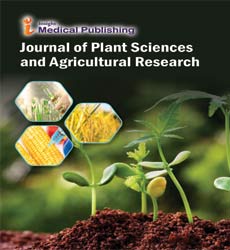Genetic Variation and Plant-Microbe Interactions for Disease Control in Endangered Plant Species
Hosen Yang*
Department of Agricultural and Environmental Sciences, McGill University, Montreal, Canada
- *Corresponding Author:
- Hosen Yang
Department of Agricultural and Environmental Sciences, McGill University, Montreal,
Canada,
E-mail: yanghosen@gmail.com
Received date: November 21, 2024, Manuscript No. IPJPSAR-24-20182; Editor assigned date: November 25, 2024, PreQC No. IPJPSAR-24-20182 (PQ); Reviewed date: December 09, 2024, QC No. IPJPSAR-24-20182; Revised date: December 16, 2024, Manuscript No. IPJPSAR-24-20182 (R); Published date: December 23, 2024, DOI: 10.36648/ipjpsar.8.4.161
Citation: Yang H (2024) Genetic Variation and Plant-Microbe Interactions for Disease Control in Endangered Plant Species. J Plant Sci Agri Res Vol.8 No.4: 161.
Description
Endangered plant species, which are at risk of extinction due to factors such as habitat loss, climate change and invasive species, are of particular interest to conservation biologists. Understanding the genetic variation within these species is critical for their preservation and recovery. Genetic diversity plays a need role in the ability of a plant species to adapt to changing environments, resist diseases and reproduce successfully. For endangered plants, maintaining and enhancing this genetic variation can help ensure the survival and resilience of populations over time.
Genetic variation in endangered plant species
Genetic variation refers to the differences in DNA among individuals within a species. In natural populations, this variation provides the raw material for evolution, enabling plants to respond to selective pressures, such as disease, drought or changing soil conditions. However, in endangered plant species, genetic variation is often limited due to small population sizes, genetic bottlenecks and habitat fragmentation. The loss of genetic diversity can reduce the ability of plants to adapt to new diseases or environmental challenges, increasing their vulnerability to extinction.
One of the key factors in conserving genetic variation in endangered plant species is to identify and protect genetically diverse populations. This can be achieved through techniques such as seed banking, in situ conservation and genetic monitoring. Seed banks store seeds from a range of individuals across different populations, preserving genetic diversity for future restoration efforts. In situ conservation involves protecting the natural habitats of endangered plants, allowing them to evolve in their native environment while maintaining their genetic diversity. Genetic monitoring helps track changes in the genetic composition of populations over time, providing valuable information for management decisions.
Research into the genetic variation of endangered plants can also lead to the identification of traits that confer resistance to specific diseases. For example, certain genotypes of endangered plants may have natural resistance to pathogens, which could be important in preventing or controlling plant diseases that threaten their survival. By studying the genetic diversity of these species, scientists can better understand the mechanisms behind disease resistance and use this knowledge to guide conservation efforts and enhance the effectiveness of restoration programs
Plant-sicrobe interactions for disease control
In addition to genetic variation, plant-microbe interactions play a pivotal role in the health and survival of endangered plant species. Plants have complex relationships with the microbes in their environment, including bacteria, fungi and viruses. These interactions can be either beneficial, neutral or harmful to the plant. Beneficial interactions, such as those with Plant Growth- Promoting Rhizobacteria (PGPR) or mycorrhizal fungi, can enhance plant health and disease resistance, making them critical for the conservation of endangered plants.
Beneficial microbes can protect plants from diseases in several ways. One of the most important mechanisms is through competition with harmful pathogens for space and nutrients. Beneficial microbes, such as certain strains of PGPR, can colonize plant roots and create a protective barrier against pathogens by outcompeting them for available resources. Additionally, some beneficial microbes produce antimicrobial compounds that directly inhibit the growth of pathogenic microorganisms. For instance, certain rhizobacteria can produce antibiotics that target plant pathogens, effectively preventing disease outbreaks in vulnerable plants.
Mycorrhizal fungi, which form symbiotic relationships with plant roots, also play an important role in plant health. These fungi enhance nutrient uptake, particularly phosphorus and can help plants cope with environmental stressors, including pathogens. Some mycorrhizal fungi can even stimulate plant immune responses, increasing the plant’s resistance to disease. For endangered plant species, the presence of beneficial microbes such as these can significantly enhance their ability to fight off infections, reduce disease incidence and improve overall plant health.
However, the relationship between plants and microbes is not always beneficial. Pathogenic microbes, including bacteria, fungi and viruses, can cause diseases that threaten the survival of endangered plant species. Plant pathogens can invade tissues, interfere with nutrient uptake and trigger immune responses that weaken the plant. In some cases, pathogens can be so virulent that they lead to the extinction of small or isolated plant populations. As a result, managing plant-microbe interactions is an important aspect of disease control in endangered plant species.
One good approach for controlling plant diseases in endangered species involves the use of microbial inoculants. By introducing beneficial microbes into the plant’s environment, researchers can enhance disease resistance and improve plant health. These inoculants can be applied to the soil, roots or foliage of endangered plants to boost the plant’s natural defense mechanisms. In some cases, microbial inoculants have been shown to increase plant growth and survival in the face of pathogen pressure, providing an effective tool for disease management in conservation efforts. Additionally, understanding the plant’s immune system and its response to microbial threats is need for developing effective disease control strategies.
Open Access Journals
- Aquaculture & Veterinary Science
- Chemistry & Chemical Sciences
- Clinical Sciences
- Engineering
- General Science
- Genetics & Molecular Biology
- Health Care & Nursing
- Immunology & Microbiology
- Materials Science
- Mathematics & Physics
- Medical Sciences
- Neurology & Psychiatry
- Oncology & Cancer Science
- Pharmaceutical Sciences
